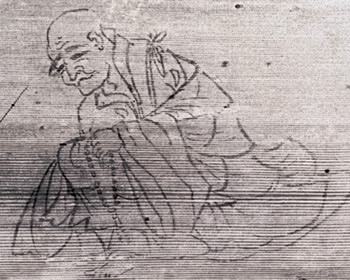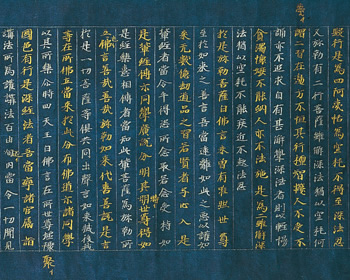Honederamura Shoen Iseki (2) アーカイブ
The History of Honederamura
The history of Honederamura began when Jizaibo Renko, the first Sutra Repository Steward of Chuson-ji, donated his private estate Honedera to Chuson-ji Sutra Repository in 1126. Renko devoted 8 years of his service to the transcription of Issai-kyo in Alternating Gold and Silver Characters on Blue Paper, which was Fujiwara no Kiyohira’s vow; the transcription was completed in 1126. For his accomplishment, Renko was appointed Chuson-ji’s first Sutra Repository Steward, and Honedera was to be administered as the domain of the Sutra Repository. From then until the end of the middle ages, Honedera would be administered by successive Sutra Repository Stewards.
 |
 |
| Jizaibo Renko | Issai-kyo in Alternating Gold and Silver Characters on Blue Paper |
Minamoto no Yoritomo and Honederamura
In 1189 Minamoto no Yoritomo defeated Yasuhira, fourth lord of the Fujiwara clan, putting an end to nearly a century of the clan’s reign over Oshu. According to Azumakagami, a historical record from the Kamakura period, Shinren, the Sutra Repository Steward of the time, visited Yoritomo who was staying at Jingaoka, Shiwa-gun, and pleaded with him for the continuation of Chuson-ji and its domain, explaining that Chuson-ji was built by Kiyohira at the wish of the retired Toba Emperor and that it was a special spiritual place where Issai-kyo in Alternating Gold and Silver Characters on Blue Paper was kept. Yoritomo immediately agreed to this; in particular, he determined the boundaries of Honederamura as follows: Kagikake in the east, Sanno no Iwaya in the west, the Iwai River in the south, and the ridgeline from Mitakedo to Masaka in the north. This allowed Honederamura to continue its existence as the domain of the Sutra Repository Steward. This would later bear significance in the border dispute with the Kasai clan, who were estate stewards of seven counties including Iwai-gun.
Honederamura Border Dispute
During the Kamakura period, there was a dispute between the Kasai clan and Chuson-ji over the possession of some mountains and fields. The testament written in 1303 by ???? the Sutra Repository Steward mentions that the order written by Minamoto no Yoritomo was presented in the shogunate court of law during the Honederamura Border Dispute. We can assume that the dispute was with the Kasai clan. The Honederamura Illustrated Map of Households was created to be used as evidence in the boundary dispute.
Organization of Honederamura and Taxation
Farmers called zaike paid taxes to Chuson-ji. According to the Honederamura Tax Record (1318), there were two types of family units, tayashikibun and tsukuridabun, for taxation purposes; 4 families were designated as tayashikibun and 10 families as tsukuridabun. The tayashikibun were the central members of the village who each paid roughly the same amount of taxes such as rough rice, polished rice, bonito, and money. The tsukuridabun appear to have been newer residents or those outside the village who could not become official members of the community; they only paid a small amount of money. Other forms of taxes included millet, dried chestnuts, and firewood at the end of the year. We can see from the great variety of taxes paid by Honederamura to Chuson-ji that the village not only thrived on rice farming but also made full use of its mountains and fields. Furthermore, since significant amounts of money were included in the taxes, we can see that monetary economy existed in the village.
The End of the Estate
In its early days Honederamura as a whole was inherited as the domain of the Sutra Repository Steward, but from the end of the Kamakura period, land within the village was divided and partially inherited, sold, bought, etc. Furthermore, during the conflict between the Northern and Southern Dynasties, the vassals of the Kasai clan ruled the village and used it to provide rice for the army. As a result, the village lost its function as an estate. The last document on Honederamura preserved at Chuson-ji is from 1435; we can assume that the village lost its function as Chuson-ji’s estate not so much after this date. However, the religious relationship between the village and Chuson-ji continued. Historically, the head priest of Daichoju-in in Chuson-ji served as the Sutra Repository Steward; even after the village ceased to be an estate, the successive head priests continued to visit the village periodically to give religious services.
Honederamura Thereafter
According to “Fudoki Goyo Kakidashi” written in the Honederamura area in 1775 and then submitted to the Sendai fief, there once was a samurai named Hondera Jurozaemon in the village. This must not have been in the medieval period since Honedera was not called Hondera until the Edo period. However, on a mountain in the north of the village, there is a site of a small mountain castle called Yogaidate, and on the foot of the mountain there is a mansion in a rice paddy called Yogai Yashiki. During the Warring States period there probably were armed local clans, and perhaps there were times when the entire village armed themselves as well. But in the Edo period, Honedera was rewritten “Hondera” and became Itsukushimura Hago Hondera. In the Meiji period it became Gembimura, and today it has become Gembi-cho, Ichinoseki City.
登録日: / 更新日:

 印刷
印刷
